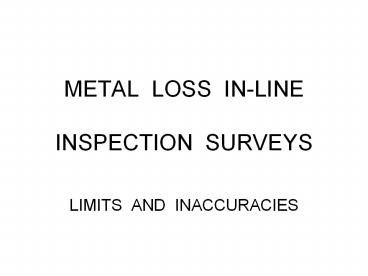METAL LOSS IN-LINE INSPECTION SURVEYS PowerPoint PPT Presentation
1 / 22
Title: METAL LOSS IN-LINE INSPECTION SURVEYS
1
METAL LOSS IN-LINEINSPECTION SURVEYS
- LIMITS AND INACCURACIES
2
BACKGROUND
- Began use in 1960s.
- Initial inspection tools were low resolution, low
power tools. - Suitable for finding where to look for corroded
pipe. - Better resolution and power offered in 1980s.
- High resolution tools began use in late 1980s.
- Despite limitations and inaccuracies, pipelines
began to calculate pressure limits based on
in-line inspection grading in late 1990s/early
2000s.
3
- INACCURACIES IN PRESSURE
- LIMIT CALCULATIONS
4
(No Transcript)
5
RUPTURES
6
LEAKS
7
High Resolution Inspection Tool Stated Limits
and Inaccuracies
- API 1160
- Inspection Companys Specs
8
API 1160 Limits onHigh Resolution Tools
- Cannot detect or reliably detect
- Narrow axial external corrosion
- Cracks and crack like defects
- Laminations and inclusions
- Pipe mill anomalies
- Can detect, but cannot identify or size
- Dents, wrinkle bends and buckles
- Gouges
9
High Resolution PigSpec. Limitations
- Cannot detect or unknown accuracy
- Surface areas smaller than t x t
- Axially oriented areas, width less than 2t
- Areas interacting with weld, smaller than 3t x 3t
- Minimum reported depth
- For t x t to 2t x 2t, 0.4t
- For larger than 2t x 2t, 0.2t
- For larger than 3t x 3t, 0.1t
- For areas interacting with weld, larger than
3t x 3t, 0.2t
10
High Resolution PigSpec. Accuracy
- Width and length
- Isolated pits, t
- Complex shapes, 2t
- Depth
- For less than t x t, unknown
- For t x t to 2t x 2t, 0.2t
- For larger than 3t x 3t, 0.1t
- For areas interacting weld, 3t x 3t and larger
- 0.2t
11
Case Study High Resolution Metal Loss Survey
- 36 miles of pipeline
- 695 metal loss anomalies deeper than 15 were
reported - Breakdown on graded wall loss
- gt 50 t 1
- 40 to 49 t 6
- 30 to 39 t 31
- 20 to 29 t 197
- 15 to 19 t 460
12
Field Inspection Results
- 200 anomalies were excavated
- Detailed records produced on 11 pipe joints
covering 62 anomalies - 90 of anomalies were deeper than graded
- 58 of anomalies were longer than graded
- 43 ungraded corrosion areas were found
13
Ungraded Corrosion Areas
- 20 to 68 deep
- 0.25 to 25 inches long
- 0.25 to 10 inches wide
- Two exceeded RSTRENG
14
Computer Display
15
Computer Display
16
Computer Display
17
Computer Display
18
Computer Display
19
Needed Post Field Inspection
Activities
- Organize graded vs. found data
- Regrade in-line inspection survey
- New field inspection plan
- Re-inspect and repair pipeline
- Statistical analysis of areas not inspected
- Apply future growth to anomalies
20
Statistical Analysis of Non-Inspected Areas
- Bayes Theorem
- First applied on TAPS
- Also called probability of exceedance (POE)
analysis - Probability that an anomaly will exceed a given
integrity criteria
21
Non-Inspected Pipe POE Summary
- POE Number of Pipe Joints
- 20-29 5
- 30-39 3
- 40-49 4
- 50-59 7
- 60-69 2
- 70-79 5
- 80-89 3
- 90-99 1
- Exceeding RSTRENG without 10 surge
allowance
22
OPS Position Needed on POE Non-Compliance Limits
- Probability to Exceed Part 192 or Part 195
- Per anomaly?
- Per pipe joint?
- Per pipeline section?
- Per pipeline inspection survey?
- Per pipeline system?
- 1, 2, 5, 10, More?

